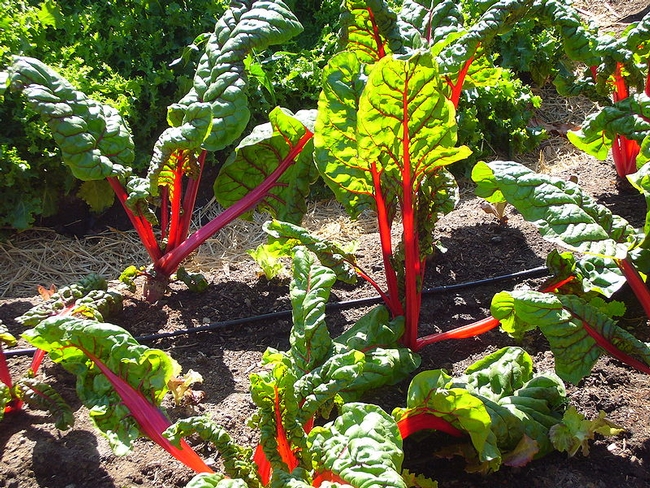October 27, 2012 - By Pat Hitchcock, U. C. Master Gardener
Lovely October! Nighttime temperatures are dipping into the forties, daylight hours are shrinking, and the tomatoes we adored in August are just not as tasty now, if in fact there are any left on the vines. If you haven’t done so already, now is the time to get some winter vegetables in the ground so you will have something fresh to eat in the cold months to come.
Among the easiest vegetables to grow are cool-season greens. You can eat them at any stage, from just barely sprouted to large and mature. Some greens, like lettuces and chicories, can be served raw in salads, and most of them can be boiled, steamed or braised. Many greens not only prefer the cooler temperatures of fall and winter, some of them actually improve in flavor if they experience light frost.
The easiest lettuces to grow are the loose-leaf types. If you are starting lettuce from seed, look for varieties labeled as cold-hardy. Local nurseries have many types available as seedlings, to give you a head start. Some nursery six-packs include a mix of types, a good choice if you like variety in your salad.
Chicories are related to lettuces and include endive, escarole and radicchio. Appreciated for their crunch and pleasant bitterness, these greens need to be grown in cool to cold weather to keep that bitterness in check. These hearty greens can be braised or enjoyed raw in winter salads with sliced persimmons or pears and toasted walnuts.
The Brassica family includes greens related to turnips and cabbage, such as arugula, collards and kale. Leafy mustards, bok choy and napa cabbage (Chinese cabbage) also belong to this family. Leaves from these plants add a lot of flavor to salads when picked young and tender. As plants mature, the greens are better suited to cooking. Brassicas are hardy and easily withstand the frosts of typical Napa Valley winters.
Also consider planting chard, beet greens and spinach this fall. These vegetables grow well in cool to cold weather. Ideally, you should start them in late summer to get them launched in warm soil, but you can still plant seedlings until the end of October. Place them in the sunniest location you have; winter days are so short that your vegetables will need as much sun as possible.
Before planting, add two to four inches of compost to your garden bed, digging it into the top few inches of soil. The organic matter in compost improves soil drainage and texture.
Consider adding fertilizer of some sort, especially if you grew summer vegetables in the same bed. Most compost is low in nitrogen and the other nutrients that growing plants need. If you are not sure what to add, go with an all-purpose formulation labeled for vegetables, and follow package directions. Too much fertilizer can harm seedlings and add unwanted chemical salts to your soil.
When transplanting seedlings, follow the recommended spacing on the plant tag. Consult a garden book if you aren’t sure. In general, place seedlings far enough apart so that they will touch only when full grown. Place leaf lettuces, arugula and spinach 8 to 12 inches apart; more vigorous greens, such as chard and cabbage, will need 12 to 18 inches between them. Handle plants carefully to minimize trauma to them, which can stunt them and reduce your yield. Plant them in moist soil, and do not let them dry out.
Water regularly until rain arrives. Often the first few storms do not bring enough moisture to wet the soil deeply, so monitor often and water as needed. Assuming a typical wet winter, your greens should not need watering unless we get a dry spell lasting more than a couple of weeks.
Common pest problems include aphids, slugs, snails, imported cabbageworm and cabbage loopers, as well as birds and deer. Watch for aphids and spray them off with water to keep them from establishing colonies. To minimize the caterpillar pests, protect your young plants with row cover. This lightweight garden cloth allows air and water through but keeps flying insects from reaching plants and laying eggs. Monitor for slugs and snails; pick them daily when they first appear to reduce their numbers and minimize their damage. Exclude birds and deer with row cover or bird netting.
Most greens grow relatively fast. In ideal conditions, lettuces and arugula reach full size in four to six weeks. But with the cold weather and reduced daylight of late fall and early winter, growth will be much slower. Pick outer leaves at any stage and leave the inner ones to keep growing to extend your harvest.
If your plants seem to grow slowly, don’t give up on them. Roots will still be developing
underground. These laggards may surprise you with a burst of growth in January or February after other plants have finished producing.
I can’t promise that you will enjoy your sweet and spicy winter greens as much as your summer tomatoes, but your harvest will be fresher and more nutritious than any greens you can buy.
Workshops: Napa County Master Gardeners conduct workshops throughout the year see our wesbite for details and registration information. http://cenapa.ucdavis.edu
